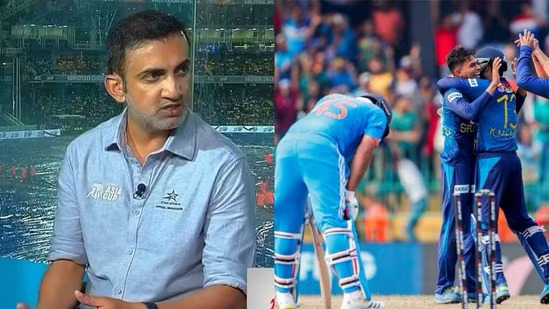

In a scathing assessment of India’s batting display against Sri Lanka, Gautam Gambhir highlighted the team’s difficulties against spin bowling. During the 2023 Asia Cup’s third Super Four match in Colombo, Sri Lankan left-arm orthodox spinner Dunith Wellalage proved to be a formidable challenge for the star-studded Indian batting lineup. Wellalage, a 20-year-old spinner with only 13 ODIs under his belt, secured an impressive five-wicket haul by dismissing key Indian batsmen, including Rohit Sharma, Shubman Gill, Virat Kohli, KL Rahul, and Hardik Pandya. This performance exposed a potential vulnerability in India’s batting order.
Former Indian cricketer Gautam Gambhir concurred with this assessment, offering a candid evaluation of India’s struggles against spin. Notably, it marked the first time India had lost all 10 wickets to spin, underscoring the growing challenge posed by spin bowlers in international cricket.
Gambhir, speaking to media during a rain delay in India’s innings, recalled a similar problem faced by Indian batsmen when confronted by Adam Zampa and Ashton Agar during an ODI against Australia earlier in the year. Six wickets fell to spin in that match, leading to India falling 21 runs short of their target of 270. Gambhir explained that three of the five dismissals against Sri Lanka occurred because the batsmen were committed to their front foot, emphasizing that adapting to spin-friendly conditions is crucial.
“This is becoming a pattern. You remember that match against Australia in Chennai when the ball was gripping a bit, and India was chasing some 260 odd runs against spinners like Adam Zampa and Ashton Agar. We couldn’t chase it. Whenever the ball grips, we struggle, and we don’t even know whether we can take the game deep. This is not a 350-run wicket…it’s of 270. Imagine if in 40 overs you are three down for 160 or 170, then when the ball grips, it is very important for the batters to adjust,” he remarked.
Wellalage was introduced after the powerplay and made an immediate impact by dismissing Gill, Rohit, and Kohli in quick succession. Gambhir noted that Wellalage’s effectiveness was due to the angle he created by delivering the ball wide of the crease, making it challenging for the batsmen to play off the front foot.
“As a batsman, we often try to play the angle, but if the ball spins from there, then things become difficult. If you deliver it closer to the wicket, then it becomes easier, but when you deliver it wider from the crease, then it becomes difficult. And that is why it is necessary to play it off the backfoot rather than the front foot, where both edges are tested,” Gambhir explained.
Gambhir also critiqued Gill’s dismissal, suggesting that he could have defended the ball instead of attempting to play it towards mid-on, which ultimately led to his downfall.
In conclusion, Gambhir’s analysis sheds light on India’s struggles against spin bowling and emphasizes the need for adaptability in challenging conditions.